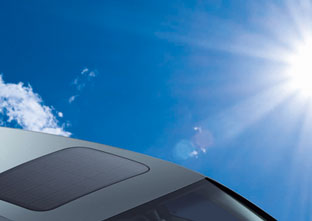
A very light future starts today
Even electric cars should be fuel efficient. All the more since we are now in the electric car pre-history and that the common species of today are still oil-addicted.
Solar energy for oil addicted cars
 Webasto solar technology has been applied to automobiles for several decades now. A new solar sunroof used monocrystalline solar cells built into the glass cover of the sunroof.
Webasto solar technology has been applied to automobiles for several decades now. A new solar sunroof used monocrystalline solar cells built into the glass cover of the sunroof.
These convert the sunlight falling on them directly into electrical energy. If the car is parked in the sun, this energy is used to drive the car fan. The continuous flow of fresh air can reduce the temperature inside the vehicle by up to 20° C, a much more pleasant atmosphere for the passengers when they get into the car.
If the vehicle is also equipped with an AC system, this cools the interior more quickly since the initial temperature is lower than it would be without parking ventilation.
The air conditioning system operates much more quietly from the start and uses less energy.
 In addition, the consistently low temperature reduces wear and tear on the materials used inside the vehicle.
In addition, the consistently low temperature reduces wear and tear on the materials used inside the vehicle.
It is also possible to feed the onboard electricity supply with solar power. This compensates for battery discharge when the vehicle is not used for some time and equipment such as mobile telephones or cool boxes can be operated using solar energy, thus saving the battery.
Webasto solar technology is also used in “smaller” areas of application. The “Solarius”, for example, a solar panel equipped with amorphous cells, is placed behind the windscreen and connected to the cigarette lighter, through which the solar electricity generated flows to the battery of the parked car, charging it over a period of time. Above all, when the engine is switched off for a long time, the battery retains its capacity to start the vehicle for much longer.
The key word is lightweight
This is valuable everywhere in a car.
The use of lighter materials offers obvious advantages: for example, ZF Sachs has studied a monotube damper with integrated CFRP (carbon fibre reinforced polymer) wheel carrier presenting further possibilities of saving weight.
This approach is usually accompanied by structural optimization with the finite element method. The physical loads which act upon a damper housing or a chassis control arm, for example, already influence the construction phase: the optimal component design can save material and the corresponding weight.
In this specific case, the combination of lightweight components and lightweight design can save a total of 60 kilograms per vehicle.

Only good qualities, except its name
 Vestakeep® is a PEEK: a polyetheretherketone.
Vestakeep® is a PEEK: a polyetheretherketone.
Car manufacturers must have good reasons to use a polymer with such a barbaric name!
Well, the reasons do exist: they are called resistance.
High mechanical strength is combined with high impact strength, resistance to high and low temperatures with good abrasion resistance and a low coefficient of friction with excellent chemical resistance, low moisture absorption is combined with very low thermal expansion, and with freedom from corrosion. Last but not the least, the whole of it comes with weight reduction.
Vehicles that care for pedestrians
 Vehicles must also provide the best possible protection for pedestrians in the event of a collision. This concerns the front part of the vehicle, commonly named the ‘Front End Module’, which must also contribute to fuel savings through weight optimization. The bumper system of Valeo's Safe4U™ module optimizes the passive protection of passengers and pedestrians.
Vehicles must also provide the best possible protection for pedestrians in the event of a collision. This concerns the front part of the vehicle, commonly named the ‘Front End Module’, which must also contribute to fuel savings through weight optimization. The bumper system of Valeo's Safe4U™ module optimizes the passive protection of passengers and pedestrians.
Two cross members are designed to absorb pedestrian and frontal impacts. The upper cross member is in steel, supporting compressible plastic absorbers. These absorbers reduce the risk of injury to crashed-into pedestrians’ lower legs. Two plastic crash boxes are attached to the cross member. These crash boxes offer the same compression ratio as steel but in a reduced packaging and are also simpler to manufacture.
And it provides a weight saving of 1.5kg (2.5kg for the whole vehicle) and reduces car overhang by 60mm.
E.valve for real savings (not e.savings)
Valeo’s THEMIS flexible E-Valve system allows infinitely variable valve timing and valve opening durations, reducing pumping losses and also enabling the deactivation of some cylinders.
In addition, opening and shutting valves at low engine speeds optimizes filling when compared to a cam system, hence improving performance at low speed. As well as improved thermodynamic performance and torque, it can also switch momentarily to a Miller Cycle, or accelerate gas intake rate and turbulence by opening one valve, thus reducing the creation of pollutant gases.
Current tests on prototype vehicles focus largely on half-camless systems, which only control inlet valves and offer the most benefits and an excellent cost-benefit ratio.






